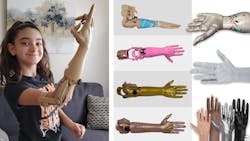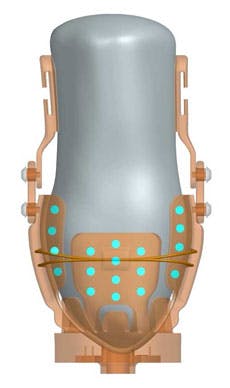Making Prosthetic Arms for Those in Need
READ MORE: Prosthetic Hand Controlled by AI and Patient’s Thoughts
There are probably over a million people in the U.S. who could use a prosthetic arm and dearly want one. That includes those who have suffered amputations or accidents and those born with congenital defects. Yet only an estimated 27% to 56% of U.S. people who could use a prosthetic arm have one, according to the National Institutes of Health.
The main reason people in need do not have a prosthetic is the price, which can go from $30,000 to $90,000 or more. In addition, the long travel time for some to the nearest prosthetic clinic or hospital for sizing and training—not to mention dealing with insurance companies—proves too frustrating and cumbersome.
This sad situation inspired Easton LaChappelle to use his extensive background in building prosthetic arms to design and market one that was affordable and longer-lasting, as well as highly capable and high quality. He was also influenced (or inspired) by his personal contact with a young girl who needed a prosthetic that was going to cost $80,000 and to make a bad situation worse, it would have to be replaced in a few years as she grew.
So LaChappelle founded Unlimited Tomorrow (UT) and directed its engineering team to design a below-the-elbow prosthetic and focus on bringing down the cost without sacrificing necessary functionality.
The result? The TrueLimb prosthetic arm/hand.
Basic Prosthetic Design
The design begins with a high-resolution scan of both the patient’s arms: the intact one and the one with the missing hand. UT engineers use the scanning data to make precise measurements so that the custom-made, 3D printed prosthetic will be a mirror image of the healthy hand/arm. The scan also lets UT print a socket that will tightly but comfortably fit the patient’s arm.
READ MORE: Patients take Mind-Controlled Prosthetics for a Test Drive
This all but eliminates the need for costly and time-consuming trial and-error fitting sessions.
The outer shell, including the socket, fingers, and joints are made out of lightweight and strong PA12 Nylon using multi-jet fusion (MJF), a 3D printing method that turns out precise, durable parts. UT has formulated 450 different colors of the nylon so patients can match their natural color; they can even add freckles or birthmarks to make it a more perfect match. If they want a more stylistic prosthetic, they can have it printed in gold, silver or black.
It takes 24 to 48 hours to print the parts, and UT then relies on natural cooling once they are complete, rather than forced cooling which can degrade part quality. Stringent quality control standards and intelligent software helps UT maintain nearly 100% yields of printed parts.
Once assembled, two Maxon DCX12S motors and GPX112HP gearheads use artificial “tendons” to independently control the thumb and index finger; a third motor and gearhead pair controls the remaining fingers, which are mechanically linked. The DC brushed motors can spin at up to 3,800 rpm, run on 6 volts, and provide 2 W of power and 1.9 mNm of torque.
The durable and highly reliable motors also use maxon’s ironless-core technology for high power density and a compact size. Using maxon’s motors and gearheads let UT increase speed and torque without increasing the size of the prosthetic, according to LaChapelle.
When the motors reel in the tendons, the fingers or thumb retract or curl; when the tendons are unreeled, they straighten out. The digits on TrueLimb have lift limits. The thumb and forefinger finger are each rated for 15 lb, while the pinky, ring, and middle fingers are collectively rated for 15 lb.
The battery can power the arm and it motor for three to five or more days, depending on how it is used. It stores up to 5,600 mAh and UT tests show it retains more than 80% of its original charge capacity after 300 charging cycles. And it can be recharged using the commonly available USB-C port and hardware. Other prosthetic uses a proprietary charger, which means the charger is only available from the company that makes the prosthesis, says UT.
The compact motors, gearheads, battery, and all the electronics are small enough to be housed in the prosthetic’s palm—even the child-sized versions.
Grips and Control
The TrueLimb hand can be commanded to form six different grips: resting, hooked, credit card, closed hand (fist), pincer, and closed tripod. Other, more costly prosthetics offer wider array of grips, but UT determined these six core grips are used for most tasks, and limiting it to six saves money.
To switch between some grips, the bionic thumb must rotate from an opposing position (used to pinch objects between the thumb and fingers) to getting out of the way (used to carry objects like a briefcase or shopping bag). Some artificial hands rotate the thumb electronically, but the UT version requires users to manually rotate the thumb into position with their free hand, another money-saving approach.
The grips are also adaptive, letting them conform to a variety of shapes. So, when preparing to grab and lift an object, each finger that participates in the selected grip closes until it meets a certain level of resistance. For example, when grabbing a ball, the thumb, forefinger, and middle finger stop closing once they encounter resistance from the upper portion of the ball. But the ring finger which is beneath the ball continues closing until it is supporting the ball.
To make the arm more intuitive and easier to use, UT engineers devised a way to control the hand that differs from how conventional prosthetics work. UT dubbed it TrueSense.
Traditional devices use just two sensors (electrodes) that are usually mounted on opposite sides of the person’s arm. They pickup electrical signals from the user’s muscles when they are flexed. This means the sensors must be placed just right on a user’s limb, and there can be no sweat or moisture that will interfere with the detection of the muscles’ electrical outputs.
TrueSense employs up to 36 sensors embedded in the socket. This 360-deg. sensor array uses proprietary technology to detect topographical or shape changes on the surface of the limb made when the user flexes certain muscles in the residual limb, not electrical signals. This means direct skin contact with these sensors is not necessary. So, users can wear a protective sock on their residual limb and perspiration, or moisture will never interfere with control of the arm. The sensors have an extensive range, letting them sense the slightest muscle movements.
There’s also a form of haptic feedback. A small device in the socket vibrates when the hand/grip contacts an object.
Changing the Customer Experience
Thanks to the ingenuity of the UT design team, the TrueLimb prosthetic weighs just 1.5 lb, is suitable for patients at least seven years old, and can be sold for just under $8,000 (or be purchased on a payment plan for $279 per month). If a patient 21 years or younger outgrows their prosthetic, which is inevitable for younger patients, UT will reuse components and rebuild it for just $4,000. UT also provides a two-year warranty on TrueLimb that covers defects in material and workmanship.
Another UT innovation is its direct-to-consumer model. As with every other bionic hand on the market, TrueLimb can be purchased through select clinics. So, if a patient wants to use a known or trusted clinician, UT will work with them. This is helpful for those using insurance coverage who need help with the paperwork.
READ MORE: Giving Artificial Hands a Sense of Touch
But if a person lacks insurance, UT does something that no other prosthetic company has done: It lets them buy TrueLimb directly from them.
During this process, patients meet online with certified prosthetists to verify they are candidates for a TrueLimb. The patient’s residual limb and healthy arm and hand are measured via software, thus eliminating the need to travel to the prosthetist’s or UT’s offices. Everything is done at the patient’s home over the internet, as is the socket-fitting process.
The finished device is mailed to the patient’s home and they are trained on using TrueLimb’s software (again online).
The TrueLimb is currently available in the U.S.A and Canada. However, the company plans to expand globally.



